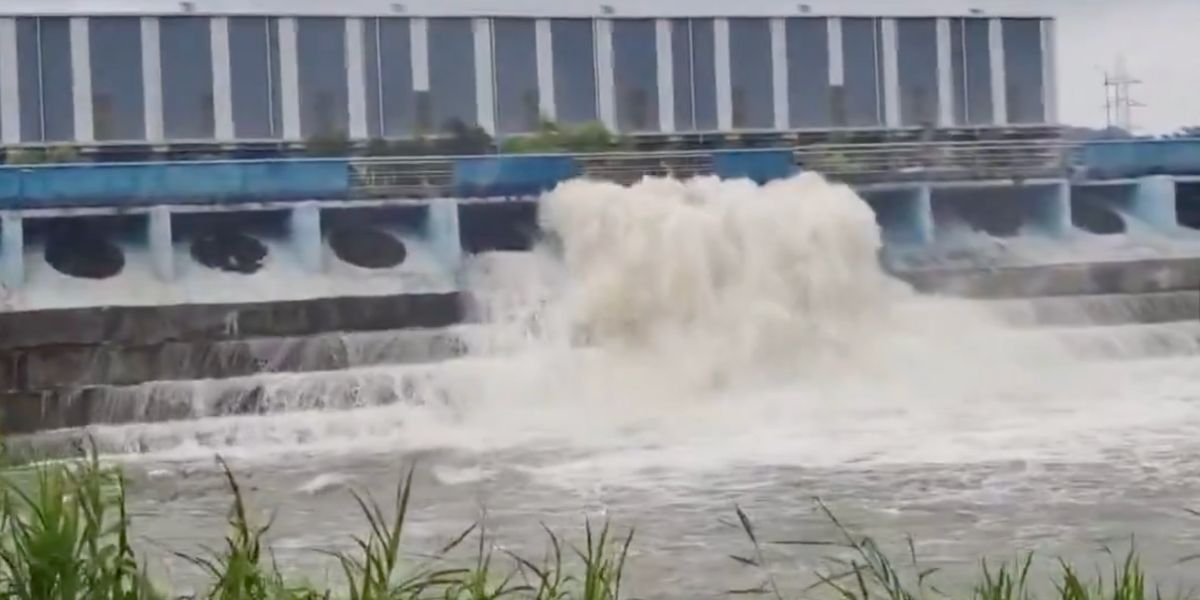Located on a flood-prone plain between the Krishna River and surrounding hillocks, the city is naturally susceptible to inundation.
Published Aug 15, 2025 | 11:40 AM ⚊ Updated Aug 15, 2025 | 11:40 AM

Officials released floodwater using Kondaveeti Vagu Lift Irrigation Scheme.
Synopsis: The Kondaveeti Vagu unleashed devastation, submerging vast stretches of the Andhra Pradesh capital region in Amaravati for the second time in less than a year. The floodwaters inundated critical sites earmarked for the new High Court and General Administration Department buildings, laying bare the inadequacies of flood management in the capital zone.
The Kondaveeti Vagu — long branded as Amaravati’s sorrow — once again unleashed devastation, submerging vast stretches of the Andhra Pradesh capital region for the second time in less than a year.
Triggered by heavy overnight rains on Tuesday, 13 August, the floodwaters inundated critical sites earmarked for the new High Court and General Administration Department (GAD) buildings, laying bare the inadequacies of flood management in the capital zone.
Originating in the Kondaveedu Hill Range near Perecherla in Guntur district, the Kondaveeti Vagu flows for about 29.5 km before merging with the Krishna River upstream of the Prakasam Barrage. During monsoons, this modest stream swells dangerously, carrying up to 15,000 cusecs of water and flooding nearly 13,500 acres, including 10,600 acres within Amaravati’s core capital area.
Its narrow channels, sharp bends, and outdated drainage systems magnify the threat, transforming dry streambeds into raging torrents within hours.
Amaravati’s very geography adds to the vulnerability. Located on a flood-prone plain between the Krishna River and surrounding hillocks, the city is naturally susceptible to inundation.
The Kondaveeti Vagu heightens the risk, as its limited carrying capacity is easily overwhelmed by sudden downpours and cloudbursts—events that experts say are becoming more frequent across the Telugu states due to ecological degradation.
The situation is worsened by the Vagu’s connection to the 47-km-long Guntur Channel, which draws water from the Prakasam Barrage for irrigation and drinking needs of the district. Backflow from the stream often enters this canal, triggering further flooding in surrounding villages.
The latest disaster, following a similar deluge in 2024, highlights the steep price the state must pay due to delays in flood mitigation. Despite repeated warnings, Amaravati remains woefully underprepared — “a sitting duck,” on plains prone to flash floods.
A comprehensive flood-control blueprint was, in fact, drawn up during Chief Minister N Chandrababu Naidu’s first term (2014–2019). Valued at ₹2,603 crore, it envisioned widening the stream to handle 23,000 cusecs, constructing reservoirs, and setting up a chain of pumping stations.
While the Kondaveeti Vagu Pump House — completed in September 2018 — can discharge 5,000 cusecs of water into the Krishna River, additional pump houses at Vaikunthapuram and Gunadavalli were left incomplete.
The change of government in 2019 proved another setback. The YSRCP, which sidelined Amaravati in favour of its three-capital plan, halted several infrastructure works, including flood-control projects.
With Naidu’s NDA government returning to power in 2024, plans were revived, and ₹1,585 crore was allocated for new reservoirs along the Kondaveeti Vagu, Palavagu and Gravity Canal. However, with these projects still stuck in tendering, Amaravati once again lay exposed when the latest floods struck.
The recurring inundations have particularly alarmed farmers who gave up their land for the capital in exchange for developed residential and commercial plots. Many now fear that raising Amaravati’s base level to 25 meters above sea level, as proposed in the master plan, is not a solution.
Critics also point out that the Krishna River once swelled to 24 meters during the 2009 floods, questioning whether the planned elevation offers flood protection.
The Andhra Pradesh Capital Region Development Authority (APCRDA) insists it is fast-tracking flood management works. Tenders for reservoirs and canals have been issued, with construction slated to begin in January 2026.
Chief Minister Naidu directed officials to follow international standards in designing these projects. Yet, as the Kondaveeti Vagu once again turned Amaravati into a waterlogged plain this week, the urgency of swift and decisive action could not be clearer.
(Edited by Muhammed Fazil.)
